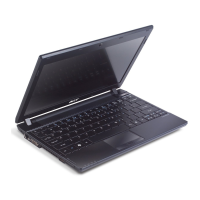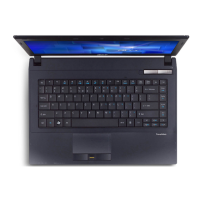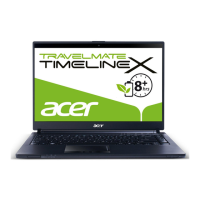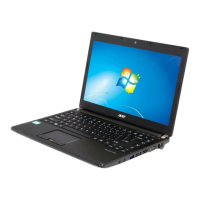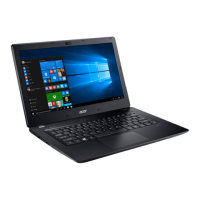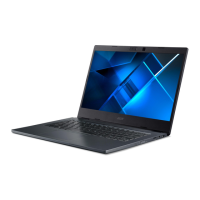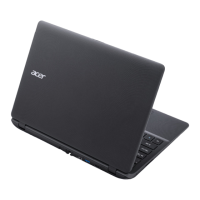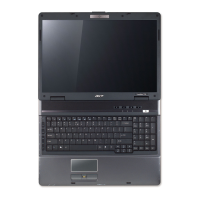
Do you have a question about the Acer TravelMate 8200 and is the answer not in the manual?
| RAM | 2 GB DDR2 |
|---|---|
| Operating System | Windows XP Professional |
| Optical Drive | DVD-Super Multi double-layer drive |
| Bluetooth | Bluetooth 2.0+EDR |
| Networking | Gigabit Ethernet |
| Processor | Intel Core Duo T2500 |
| Storage | 120 GB HDD |
| Display | 15.4-inch WXGA |
| Graphics | ATI Mobility Radeon X1600 |
| Chipset | Intel 945PM Express |
| Wireless | Intel PRO/Wireless 3945ABG (802.11a/b/g) |
| Battery | 6-cell Li-ion |
| Ports | VGA, S-Video |
Covers basic safety, handling precautions, and listening safety.
Details cautions for plug, accessibility, and slot protection.
Provides warnings on usage, placement, and electrical power guidelines.
Explains when to seek qualified service and handling of controls.
Discusses replacing lithium batteries and safety warnings.
Covers telephone, additional, operating environment, and medical device safety.
Addresses safety for pacemakers, hearing aids, vehicles, and explosive environments.
Outlines emergency calls, disposal instructions, and mercury advisories.
Offers tips for comfortable use, vision care, and good work habits.
Introduces the "Just for Starters" poster and user guides.
Instructions for powering the computer on and off.
Covers care for the computer's body, display, and AC adapter.
Details care for the battery pack and cleaning procedures for the computer.
Introduces the suite, its utilities, and password initialization.
Details Acer eNet Management for network settings and ePower Management for battery.
Explains ePresentation for displays and eDataSecurity for file encryption.
Covers eLock for device security and eRecovery for system backups.
Describes eSettings for hardware specs and Windows Mobility Center for system settings.
Illustrates front, closed, side, rear, and base views with component descriptions.
Details the left, right, and rear views with port and connector information.
Describes components located on the bottom of the notebook.
Lists comprehensive hardware and software specifications for the notebook.
Lists OS, CPU, chipset, and wireless network features.
Details LCD resolution, colors, refresh rate, and graphics card.
Covers storage options, power subsystem, battery, and input devices.
Details communication ports, I/O interfaces, and audio support.
Lists security features, software applications, and optional accessories.
Specifies operating environment conditions and warranty information.
Explains HDD, Num Lock, Caps Lock, Power, Battery, Bluetooth, Wireless LAN indicators.
Describes the function of the four easy-launch buttons and their default applications.
Details how to use the touchpad for cursor movement, selection, and scrolling.
Covers lock keys, embedded numeric keypad, Windows keys, hotkeys, and special keys.
Covers multimedia utilities and functions of the remote control.
Provides guidance on disconnecting, moving, packing, and traveling with the notebook.
Explains using security locks and managing passwords for system protection.
Details modem, network, USB, IEEE 1394, PC Card, ExpressCard, and memory installation.
Guides users through BIOS settings, boot sequence, and recovery options.
Explains how to play DVD movies and manage region codes.
Details system backup, disc burning, and restore/recovery procedures.
Provides tips and solutions for common system problems and error messages.
Outlines FCC, Canadian, EU, and modem-related regulations and safety notices.
Covers laser, LCD pixel statements, and copyright protection notices.
Details radio device notices and FCC RF safety requirements for wireless use.
Includes FCC/EU declarations and LCD panel ergonomic specifications.


